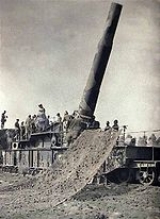
Railway gun
Encyclopedia
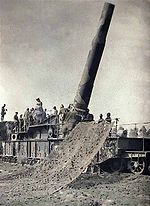
Artillery
Originally applied to any group of infantry primarily armed with projectile weapons, artillery has over time become limited in meaning to refer only to those engines of war that operate by projection of munitions far beyond the range of effect of personal weapons...
piece, often surplus naval ordnance, mounted on, transported by, and fired from a specially designed railway wagon. Many countries have built railway guns, but the best known are the large Krupp
Krupp
The Krupp family , a prominent 400-year-old German dynasty from Essen, have become famous for their steel production and for their manufacture of ammunition and armaments. The family business, known as Friedrich Krupp AG Hoesch-Krupp, was the largest company in Europe at the beginning of the 20th...
-built pieces used by Germany in World War I
World War I
World War I , which was predominantly called the World War or the Great War from its occurrence until 1939, and the First World War or World War I thereafter, was a major war centred in Europe that began on 28 July 1914 and lasted until 11 November 1918...
and World War II
World War II
World War II, or the Second World War , was a global conflict lasting from 1939 to 1945, involving most of the world's nations—including all of the great powers—eventually forming two opposing military alliances: the Allies and the Axis...
. Smaller guns were often part of an armoured train
Armoured train
An armoured train is a train protected with armour. They are usually equipped with railroad cars armed with artillery and machine guns. They were mostly used during the late 19th and early 20th century, when they offered an innovative way to quickly move large amounts of firepower...
.
Railway guns have been rendered obsolete by advances in technology. Their large size and limited mobility make them vulnerable to attack, and similar payloads can be delivered by aircraft, rocket
Rocket
A rocket is a missile, spacecraft, aircraft or other vehicle which obtains thrust from a rocket engine. In all rockets, the exhaust is formed entirely from propellants carried within the rocket before use. Rocket engines work by action and reaction...
, or missile
Missile
Though a missile may be any thrown or launched object, it colloquially almost always refers to a self-propelled guided weapon system.-Etymology:The word missile comes from the Latin verb mittere, meaning "to send"...
.
Design considerations
The design of a railroad gun has three issues over and above those of an ordinary artillery piece to consider. Namely how the gun is going to be traversed - i.e. moved from side to side to aim; how the horizontal component of the recoil force will be absorbed by the gun's carriage and how the vertical recoil force will be absorbed by the ground.Methods of traverse
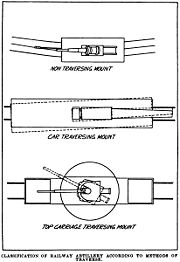

Recoil systems
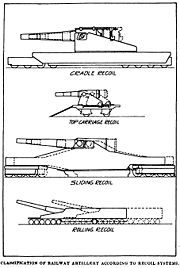


Cradle recoil means that the gun recoils backward in its cradle, retarded and stopped by hydraulic buffers. It is returned to battery, or the firing position, by either helical springs or by air in a pneumatic recuperator cylinder that is compressed by the force of recoil. This is the most common method used for lighter railroad guns and for virtually all field artillery designed after the French introduced their Canon de 75 modèle 1897
Canon de 75 modèle 1897
The French 75mm field gun was a quick-firing field artillery piece adopted in March 1898. Its official French designation was: Matériel de 75mm Mle 1897. It was commonly known as the French 75, simply the 75 and Soixante-Quinze .The French 75 is widely regarded as the first modern artillery piece...
.
Top-carriage recoil is where the gun is mounted in an upper carriage that moves on wheels on fixed rails. The gun and upper carriage recoil together, restrained by the usual hydraulic buffers. Return to battery is effected either by gravity, through the use of inclined rails, which the gun and carriage have run up, by springs, or even by rubber bands, on some improvised mounts. It is not well-suited to firing at high elevations because it can't absorb much of the vertical component of the recoil force.
Sliding recoil has the car body sitting on a set of wooden crossbeams or "sleepers" placed underneath it which have been jacked down on to a special set of girders incorporated into the track so that about half the weight of the mount has been transferred to them from the trucks
Bogie
A bogie is a wheeled wagon or trolley. In mechanics terms, a bogie is a chassis or framework carrying wheels, attached to a vehicle. It can be fixed in place, as on a cargo truck, mounted on a swivel, as on a railway carriage/car or locomotive, or sprung as in the suspension of a caterpillar...
. The gun, car body and trucks all recoil together with the friction generated by the crossbeams sliding on the girders absorbing the recoil force after moving only about 1 to 2 m (3.3 to 6.6 ft) to the rear. The sleepers must be jacked up again to allow the gun to roll forward to its firing position. This was often done by handwheels driving gear trains attached to the wheels, or even by electric motors on more modern mounts. Almost all of these type of mounts were of the non-traversing type and had to be fired from a curved section of track or turntable. The American post-World War I assessment of railroad artillery praised its ruggedness, ease of manufacture and convenience in service, but acknowledged its unsuitability for smaller guns, due to excessive time of operation and lack of traverse, and that it was not suitable for the largest howitzers firing at high angles because of the enormous trunnion forces.
With rolling recoil the entire gun, mount and everything rolls backward, typically between 30 to 50 ft (9.1 to 15.2 m), restrained only by the brakes. The mount was winched back into firing position by cables fastened to the track. This system was usually combined with cradle recoil because the springs of the trucks cannot withstand the vertical component of the recoil force alone. This type of mount was usually fitted with car-traverse. It was unsuitable for smaller guns due to the lack of traverse.. The great advantage of this method is that it requires minimal preparation and can fire from any suitable section of curved track.
The methods were often used in combination with each other. Examples include the French 520 mm (20.5 in) railway howitzer which used cradle-sliding recoil. The American 14"/50 caliber railway gun
14"/50 caliber railway gun
The 14"/50 caliber railway guns were spare US Navy Mk 4 14 inch/50 caliber guns mounted on railway cars and operated by US Navy crews in France in the closing months of World War I.-Background:...
Mark II used cradle-rolling recoil as did the British 14
BL 14 inch Railway Gun
Ordnance BL 14 inch gun on truck, railway were 2 British 14 inch Mk III naval guns mounted on railway carriages, used on the Western Front in 1918...
and 12 inch
BL 12 inch Railway Gun
The Ordnance BL 12 inch gun Mk IX on truck, railway mounted surplus 12 inch Mk IX W naval guns, manufactured by Woolwich Arsenal in 1906, on various railway platforms to provide mobile long-range heavy artillery on the Western Front in World War I....
railway guns. Only the oldest weapons used a combination of top-cradle and sliding recoil. One example being the earliest mounts for the British BL 9.2 inch Railway Gun
BL 9.2 inch Railway Gun
The Ordnance BL 9.2 inch gun on truck, railway mounted a variety of surplus 9.2 inch naval guns, together with the custom-designed Mk XIII railway gun, on various railway platforms to provide mobile long-range heavy artillery on the Western Front in World War I.-Second Boer War...
.
Anchorage

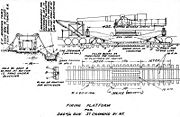
BL 9.2 inch Railway Gun
The Ordnance BL 9.2 inch gun on truck, railway mounted a variety of surplus 9.2 inch naval guns, together with the custom-designed Mk XIII railway gun, on various railway platforms to provide mobile long-range heavy artillery on the Western Front in World War I.-Second Boer War...
and 12 inch howitzers
BL 12 inch Railway Howitzer
The Ordnance BL 12 inch howitzer on truck, railway was developed following the success of the 9.2 inch siege howitzer. It was similar but unrelated to the 12 inch siege howitzers Mk II and IV.-Mark I:Mk I was introduced from March 1916...
used rail clamps or guys. The American 8 in (203.2 mm) gun and the French 240 mm Canon de Mle 1893/96 M used struts.
The other method is build a firing position and recoil pit (épi de tir in French) underneath the tracks, using either heavy timbers like the French 340 mm (13.4 in) and 400 mm (15.7 in) howitzers or an elaborate concrete or steel base. These latter were mostly used by the Germans for the 21 cm (8.3 in) and larger railroad guns and by the French for their Batignolle mounts. Generally, for these emplacements the rails merely served to guide the gun into position and the gun was often mounted on a central pivot to allow up to 360° of traverse. The primary drawback of these positions was the lengthy time to build them.
19th century
The idea of railway guns appears to have been first suggested in the 1860s by a Mr Anderson, who published a pamphlet in the United KingdomUnited Kingdom
The United Kingdom of Great Britain and Northern IrelandIn the United Kingdom and Dependencies, other languages have been officially recognised as legitimate autochthonous languages under the European Charter for Regional or Minority Languages...
titled National Defence in which he proposed a plan of ironclad railway carriages. A Russian, Lebedew, claimed to have first invented the idea in 1860 when he is reported to have mounted a mortar
Mortar (weapon)
A mortar is an indirect fire weapon that fires explosive projectiles known as bombs at low velocities, short ranges, and high-arcing ballistic trajectories. It is typically muzzle-loading and has a barrel length less than 15 times its caliber....
on a railway car.
American Civil War
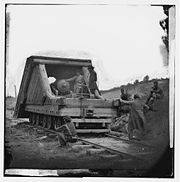
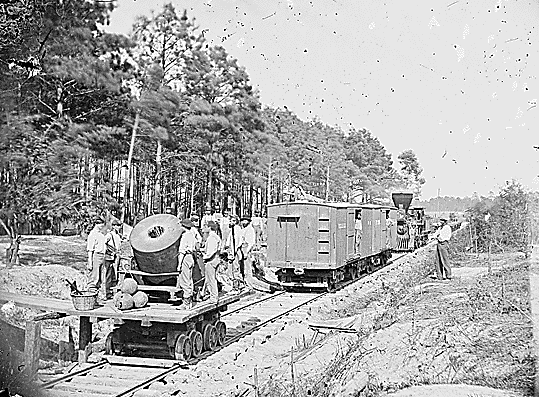
Robert E. Lee
Robert Edward Lee was a career military officer who is best known for having commanded the Confederate Army of Northern Virginia in the American Civil War....
had the gun pushed by a locomotive over the Richmond and York River line (later part of the Southern Railway) and used at the Battle of Savage's Station
Battle of Savage's Station
The Battle of Savage's Station took place on June 29, 1862, in Henrico County, Virginia, as fourth of the Seven Days Battles of the American Civil War. The main body of the Union Army of the Potomac began a general withdrawal toward the James River. Confederate Brig. Gen. John B. Magruder pursued...
to interfere with General George McClellan
George McClellan
George B. McClellan was an American Civil War military leader, Presidential candidate and Governor of New Jersey.George McClellan may also refer to:*George McClellan , American physician who founded medical schools...
's plans for siege operations against Richmond
Seven Days Battles
The Seven Days Battles was a series of six major battles over the seven days from June 25 to July 1, 1862, near Richmond, Virginia during the American Civil War. Confederate General Robert E. Lee drove the invading Union Army of the Potomac, commanded by Maj. Gen. George B. McClellan, away from...
during the Union advance up the peninsula. Photographic evidence exists of at least one Union 13-inch siege mortar mounted on a rail car during the Siege of Petersburg
Siege of Petersburg
The Richmond–Petersburg Campaign was a series of battles around Petersburg, Virginia, fought from June 9, 1864, to March 25, 1865, during the American Civil War...
. It was nicknamed the Dictator or the Petersburg Express. Another photo exists of a gun mounted on an armored rail car with the caption of "Railway battery used in siege of Petersburg" although no textual evidence survives in support of the caption, which makes the claim that it is a photo of the Confederate gun from 1862 dubious.
France
France
The French Republic , The French Republic , The French Republic , (commonly known as France , is a unitary semi-presidential republic in Western Europe with several overseas territories and islands located on other continents and in the Indian, Pacific, and Atlantic oceans. Metropolitan France...
also used improvised railways guns during the Siege of Paris
Siege of Paris
The Siege of Paris, lasting from September 19, 1870 – January 28, 1871, and the consequent capture of the city by Prussian forces led to French defeat in the Franco-Prussian War and the establishment of the German Empire as well as the Paris Commune....
in 1870 and the United Kingdom
United Kingdom
The United Kingdom of Great Britain and Northern IrelandIn the United Kingdom and Dependencies, other languages have been officially recognised as legitimate autochthonous languages under the European Charter for Regional or Minority Languages...
mounted a few 4.7 in (119.4 mm) guns on railway cars which saw action during the Siege
Siege of Ladysmith
The Siege of Ladysmith was a protracted engagement in the Second Boer War, taking place between 30 October 1899 and 28 February 1900 at Ladysmith, Natal.-Background:...
and Relief of Ladysmith
Relief of Ladysmith
When the Second Boer War broke out on 11 October 1899, the Boers had a numeric superiority within Southern Africa. They quickly invaded the British territory and laid siege to Ladysmith, Kimberley and Mafeking...
during the Second Boer War
Second Boer War
The Second Boer War was fought from 11 October 1899 until 31 May 1902 between the British Empire and the Afrikaans-speaking Dutch settlers of two independent Boer republics, the South African Republic and the Orange Free State...
. A 9.2 inch gun
BL 9.2 inch Railway Gun
The Ordnance BL 9.2 inch gun on truck, railway mounted a variety of surplus 9.2 inch naval guns, together with the custom-designed Mk XIII railway gun, on various railway platforms to provide mobile long-range heavy artillery on the Western Front in World War I.-Second Boer War...
was taken from the Cape Town
Cape Town
Cape Town is the second-most populous city in South Africa, and the provincial capital and primate city of the Western Cape. As the seat of the National Parliament, it is also the legislative capital of the country. It forms part of the City of Cape Town metropolitan municipality...
coast defenses and mounted on a rail car to support the British assault on Boer defences at Belfast
Battle of Bergendal
The Battle of Bergendal was the last set-piece battle of the Second Anglo-Boer War. It lasted from 21–27 August 1900 and took place on the farm Bergendal near the town of Belfast...
, north-east of Johannesburg
Johannesburg
Johannesburg also known as Jozi, Jo'burg or Egoli, is the largest city in South Africa, by population. Johannesburg is the provincial capital of Gauteng, the wealthiest province in South Africa, having the largest economy of any metropolitan region in Sub-Saharan Africa...
, but the battle ended before it could get into action.
In France, Lt. Col Peigné is often credited with designing the first railway gun in 1883. Commandant Mougin is credited with putting guns on railcars in 1870. The French
France
The French Republic , The French Republic , The French Republic , (commonly known as France , is a unitary semi-presidential republic in Western Europe with several overseas territories and islands located on other continents and in the Indian, Pacific, and Atlantic oceans. Metropolitan France...
arms maker, Schneider
Schneider Electric
Schneider Electric is a French global company. It was founded in 1836 by two brothers, Eugène and Adolphe Schneider.In the first part of the 20th century, Schneider et Cie associated itself with Westinghouse Systems, a major international electrical group at the time. The group began manufacturing...
offered a number of models in the late 1880s and produced a 120 mm (4.7 in) gun intended for coastal defense, selling some to the Danish
Denmark
Denmark is a Scandinavian country in Northern Europe. The countries of Denmark and Greenland, as well as the Faroe Islands, constitute the Kingdom of Denmark . It is the southernmost of the Nordic countries, southwest of Sweden and south of Norway, and bordered to the south by Germany. Denmark...
government in the 1890s. They also designed a 200 mm (7.9 in) model for Peru
Peru
Peru , officially the Republic of Peru , is a country in western South America. It is bordered on the north by Ecuador and Colombia, on the east by Brazil, on the southeast by Bolivia, on the south by Chile, and on the west by the Pacific Ocean....
in 1910, but they were never delivered.
World War I
The outbreak of the First World War caught the French with a shortage of heavy field artillery. In compensation, large numbers of large static coastal defense guns and naval guns were moved to the front, but these were typically unsuitable for field use and required some kind of mounting. The railway gun provided the obvious solution. By 1916, both sides were deploying railway guns.Baldwin Locomotive Works
Baldwin Locomotive Works
The Baldwin Locomotive Works was an American builder of railroad locomotives. It was located in Philadelphia, Pennsylvania, originally, and later in nearby Eddystone, Pennsylvania. Although the company was very successful as a producer of steam locomotives, its transition to the production of...
delivered five 14"/50 caliber railway gun
14"/50 caliber railway gun
The 14"/50 caliber railway guns were spare US Navy Mk 4 14 inch/50 caliber guns mounted on railway cars and operated by US Navy crews in France in the closing months of World War I.-Background:...
s on trains for the United States Navy
United States Navy
The United States Navy is the naval warfare service branch of the United States Armed Forces and one of the seven uniformed services of the United States. The U.S. Navy is the largest in the world; its battle fleet tonnage is greater than that of the next 13 largest navies combined. The U.S...
during April and May 1918. Each train transported and supported a Mk 4 14"/50 caliber gun
14"/50 caliber gun
The 14"/50 caliber gun was a naval gun mounted on and s. These ships also featured the first "three-gun" turrets, meaning that each gun in each turret could be "individually sleeved" to elevate separately...
, a 14 in (355.6 mm) naval rifle used on New Mexico
New Mexico class battleship
The New Mexico class battleships of the United States Navy, all three of whose construction began in 1915, were improvements on the design introduced three years earlier with the Nevada class....
and Tennessee
Tennessee class battleship
The Tennessee class was a class of battleships of the United States Navy. The class comprised two ships: and the . They were modified versions of the featuring improved underwater armor for better torpedo protection and 30 degree elevation on their main batteries, as opposed to 15 degrees for...
class battleships, mounted on a rail carriage with four 6-wheel bogies. The locomotive
Steam locomotive
A steam locomotive is a railway locomotive that produces its power through a steam engine. These locomotives are fueled by burning some combustible material, usually coal, wood or oil, to produce steam in a boiler, which drives the steam engine...
, ammunition cars, supporting equipment cars, and accommodation cars for the crew were under the command of a United States Navy lieutenant, and under overall command of Rear Admiral Charles Peshall Plunkett
Charles Peshall Plunkett
Rear Admiral Charles Peshall Plunkett, was an officer of the United States Navy who served in the Spanish-American War and World War I.-Biography:...
. After delivery by ship, these trains were assembled in St. Nazaire in August and fired a total of 782 shells during 25 days on the western front at ranges between 27 and 36 km (29,527.6 and 39,370.1 yd). The railway carriages could elevate the guns to 43 degrees, but elevations over 15 degrees required excavation of a pit with room for the gun to recoil and structural steel shoring foundations to prevent caving of the pit sides from recoil forces absorbed by the surrounding soil. The train included cars to transport recoil pit foundations constructed by Baldwin. One of these guns is on display outside the museum
U.S. Navy Museum
The National Museum of the United States Navy, or U.S. Navy Museum for short, is the flagship museum of the United States Navy and is located in the former Breech Mechanism Shop of the old Naval Gun Factory on the grounds of the Washington Navy Yard in Washington, D.C., USA.The U.S...
at the Washington Navy Yard
Washington Navy Yard
The Washington Navy Yard is the former shipyard and ordnance plant of the United States Navy in Southeast Washington, D.C. It is the oldest shore establishment of the U.S. Navy...
.
Baldwin constructed six similar gun carriages and two of an improved Mk II type designed to permit firing the gun at all elevation angles without transferring weight to a separate foundation. These eight guns were completed too late to see combat, although some were stationed through World War II
World War II
World War II, or the Second World War , was a global conflict lasting from 1939 to 1945, involving most of the world's nations—including all of the great powers—eventually forming two opposing military alliances: the Allies and the Axis...
in special coast defense installations at San Pedro, California (near Los Angeles
Los Ángeles
Los Ángeles is the capital of the province of Biobío, in the commune of the same name, in Region VIII , in the center-south of Chile. It is located between the Laja and Biobío rivers. The population is 123,445 inhabitants...
) and at the Panama Canal
Panama Canal
The Panama Canal is a ship canal in Panama that joins the Atlantic Ocean and the Pacific Ocean and is a key conduit for international maritime trade. Built from 1904 to 1914, the canal has seen annual traffic rise from about 1,000 ships early on to 14,702 vessels measuring a total of 309.6...
Zone where they could be shifted from one ocean to the other in less than a day. Improved carriages were designed to allow transport to several fixed firing emplacements including concrete foundations where the railway trucks were withdrawn so the gun could be rapidly traversed (swiveled horizontally) to engage moving ship targets.
The United States constructed approximately fifty smaller depressed center railway carriages on two 6-wheel bogies for 8 inch (203 mm) naval rifles made surplus by the Washington Naval Treaty
Washington Naval Treaty
The Washington Naval Treaty, also known as the Five-Power Treaty, was an attempt to cap and limit, and "prevent 'further' costly escalation" of the naval arms race that had begun after World War I between various International powers, each of which had significant naval fleets. The treaty was...
. Approximately a dozen of these were used for the defense of Oahu
Oahu
Oahu or Oahu , known as "The Gathering Place", is the third largest of the Hawaiian Islands and most populous of the islands in the U.S. state of Hawaii. The state capital Honolulu is located on the southeast coast...
. Others were stationed through World War II
World War II
World War II, or the Second World War , was a global conflict lasting from 1939 to 1945, involving most of the world's nations—including all of the great powers—eventually forming two opposing military alliances: the Allies and the Axis...
for coast defense of Manila
Manila
Manila is the capital of the Philippines. It is one of the sixteen cities forming Metro Manila.Manila is located on the eastern shores of Manila Bay and is bordered by Navotas and Caloocan to the north, Quezon City to the northeast, San Juan and Mandaluyong to the east, Makati on the southeast,...
, Bermuda
Bermuda
Bermuda is a British overseas territory in the North Atlantic Ocean. Located off the east coast of the United States, its nearest landmass is Cape Hatteras, North Carolina, about to the west-northwest. It is about south of Halifax, Nova Scotia, Canada, and northeast of Miami, Florida...
, Newfoundland, Puget Sound
Puget Sound
Puget Sound is a sound in the U.S. state of Washington. It is a complex estuarine system of interconnected marine waterways and basins, with one major and one minor connection to the Strait of Juan de Fuca and the Pacific Ocean — Admiralty Inlet being the major connection and...
, the Columbia River
Columbia River
The Columbia River is the largest river in the Pacific Northwest region of North America. The river rises in the Rocky Mountains of British Columbia, Canada, flows northwest and then south into the U.S. state of Washington, then turns west to form most of the border between Washington and the state...
, Chesapeake Bay
Chesapeake Bay
The Chesapeake Bay is the largest estuary in the United States. It lies off the Atlantic Ocean, surrounded by Maryland and Virginia. The Chesapeake Bay's drainage basin covers in the District of Columbia and parts of six states: New York, Pennsylvania, Delaware, Maryland, Virginia, and West...
, Delaware Bay
Delaware Bay
Delaware Bay is a major estuary outlet of the Delaware River on the Northeast seaboard of the United States whose fresh water mixes for many miles with the waters of the Atlantic Ocean. It is in area. The bay is bordered by the State of New Jersey and the State of Delaware...
, and Fort Hancock, New Jersey
Fort Hancock, New Jersey
Fort Hancock is a former United States Army fort at Sandy Hook, located in Middletown Township in Monmouth County, along the Atlantic coast of eastern New Jersey in the United States. This coastal artillery base played an important part in the defense of New York Harbor and played a role in the...
(near New York City
New York City
New York is the most populous city in the United States and the center of the New York Metropolitan Area, one of the most populous metropolitan areas in the world. New York exerts a significant impact upon global commerce, finance, media, art, fashion, research, technology, education, and...
).
In 1930 the US Army tested 12 inch mortars that were train based that could be moved to different locations of the country in a time of crisis.
Schneider of France developed the Obusier de 520 modèle 1916
Obusier de 520 modèle 1916
The Obusier de 520 modèle 1916 was a French railroad gun that was built during World War I, but did not see service before the war ended. One gun was captured by the Germans after France surrendered in 1940 and used by them in the Siege of Leningrad...
, a 20 inch (520mm) railway "Fort Buster" to do what the German 16" Big Bertha
Big Bertha (Howitzer)
Big Bertha Bertha") is the name of a type of super-heavy howitzer developed by the famous armaments manufacturer Krupp in Germany on the eve of World War I...
had done at the outbreak of ww1 but to reduce the German forts in the final line of German defences. One was destroyed in trials and the other did not complete firing trials prior to the signing of the Armistice. The gun remained in storage and was captured by the Germans during World War II. It later formed part of the German artillery complement during the Siege of Leningrad
Siege of Leningrad
The Siege of Leningrad, also known as the Leningrad Blockade was a prolonged military operation resulting from the failure of the German Army Group North to capture Leningrad, now known as Saint Petersburg, in the Eastern Front theatre of World War II. It started on 8 September 1941, when the last...
. The gun was disabled by a premature detonation and later abandoned.
World War II
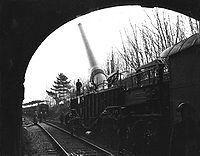
Schwerer Gustav
Schwerer Gustav and Dora were the names of two massive World War II German 80 cm K railway siege guns. They were developed in the late 1930s by Krupp for the express purpose of destroying heavy fortifications, specifically those in the French Maginot Line...
gun, the largest artillery piece to be used in combat, deployed by Germany
Germany
Germany , officially the Federal Republic of Germany , is a federal parliamentary republic in Europe. The country consists of 16 states while the capital and largest city is Berlin. Germany covers an area of 357,021 km2 and has a largely temperate seasonal climate...
. The rise of the aeroplane effectively ended the usefulness of the railway gun. Similar to battleship
Battleship
A battleship is a large armored warship with a main battery consisting of heavy caliber guns. Battleships were larger, better armed and armored than cruisers and destroyers. As the largest armed ships in a fleet, battleships were used to attain command of the sea and represented the apex of a...
s, they were massive, expensive, and, in the correct conditions, easily destroyed from the air.
Both Germany and Great Britain
Great Britain
Great Britain or Britain is an island situated to the northwest of Continental Europe. It is the ninth largest island in the world, and the largest European island, as well as the largest of the British Isles...
employed railway-mounted guns that were capable of firing across the English Channel
English Channel
The English Channel , often referred to simply as the Channel, is an arm of the Atlantic Ocean that separates southern England from northern France, and joins the North Sea to the Atlantic. It is about long and varies in width from at its widest to in the Strait of Dover...
between the areas around Dover
Dover
Dover is a town and major ferry port in the home county of Kent, in South East England. It faces France across the narrowest part of the English Channel, and lies south-east of Canterbury; east of Kent's administrative capital Maidstone; and north-east along the coastline from Dungeness and Hastings...
and Calais
Calais
Calais is a town in Northern France in the department of Pas-de-Calais, of which it is a sub-prefecture. Although Calais is by far the largest city in Pas-de-Calais, the department's capital is its third-largest city of Arras....
. Germany employed a number of 40 cm guns. Britain
United Kingdom
The United Kingdom of Great Britain and Northern IrelandIn the United Kingdom and Dependencies, other languages have been officially recognised as legitimate autochthonous languages under the European Charter for Regional or Minority Languages...
employed three 13.5 inches (342.9 mm) railway mounted guns on the East Kent Light Railway
East Kent Light Railway
The East Kent Light Railway was part of the Colonel Stephens group of cheaply built rural light railways in England. Holman Fred Stephens was engineer from its inception, subsequently becoming director and manager...
, located around Lydden
Lydden
Lydden is also the name of a hamlet in the Manston, Kent civil parishLydden is a civil parish and small village in the Dover district of Kent, England...
and Shepherdswell
Shepherdswell
Shepherdswell is a village in Kent, England, UK. It is notable for the East Kent Railway, whose terminus is sited there.This was originally one of Colonel Stephens' lines & ran to Wingham.The section as far as Eythorne is now run by a preservation society.The village social life centres around the...
. These were known as Gladiator, Sceneshifter and Piecemaker. 9.2 inch Mark 13 guns
BL 9.2 inch Railway Gun
The Ordnance BL 9.2 inch gun on truck, railway mounted a variety of surplus 9.2 inch naval guns, together with the custom-designed Mk XIII railway gun, on various railway platforms to provide mobile long-range heavy artillery on the Western Front in World War I.-Second Boer War...
were located near Canterbury
Canterbury
Canterbury is a historic English cathedral city, which lies at the heart of the City of Canterbury, a district of Kent in South East England. It lies on the River Stour....
and Hythe
Hythe, Kent
Hythe , is a small coastal market town on the edge of Romney Marsh, in the District of Shepway on the south coast of Kent. The word Hythe or Hithe is an Old English word meaning Haven or Landing Place....
; an 18 inch Howitzer
BL 18 inch railway howitzer
The British Ordnance BL 18 inch howitzer on truck, railway was developed during World War I as part of the progression of ever-larger howitzers on the Western Front, but did not enter service until 1920.-History:...
, Boche Buster, sited on the Elham Valley Railway
Elham Valley Railway
The Elham Valley Railway is a disused railway line that runs through the Elham Valley connecting Folkestone and Canterbury in East Kent. It was operational from 1887 to 1947.- History :...
, between Bridge
Bridge, Kent
Bridge is a village and civil parish near Canterbury in Kent, South East England.Bridge village is situated in the Nailbourne valley in a rural setting on the old Roman road, Watling Street, formerly the main road between London and Dover...
and Lyminge
Lyminge
Lyminge is a village in southeast Kent, England. It lies about five miles from Folkestone and the Channel Tunnel, on the road passing through the Elham Valley. The Nailbourne stream begins in the village and flows north through the Valley, to become one of the tributary streams of the Great Stour...
; and 12 inch howitzers, Mk 3 and 5
BL 12 inch Railway Howitzer
The Ordnance BL 12 inch howitzer on truck, railway was developed following the success of the 9.2 inch siege howitzer. It was similar but unrelated to the 12 inch siege howitzers Mk II and IV.-Mark I:Mk I was introduced from March 1916...
, located around Guston
Guston
Guston is a village near Dover in Kent, England. The village lies about a quarter of a mile North of the campus of the Duke of York's Royal Military School, near Martin Mill. The village, in the 1950s, was the site of one public house, one post office, one Saxon church and about one-hundred homes....
.
Surviving railway guns
- A 12 inch railway gun is preserved at the Naval Surface Warfare Center Dahlgren DivisionNaval Surface Warfare Center Dahlgren DivisionThe United States Naval Surface Warfare Center, Dahlgren Division , named for Rear Admiral John A. Dahlgren, is located in Dahlgren, Virginia and is part of the Naval Surface Warfare Center. The NSWCDD was founded as the U.S...
, Dahlgren, VirginiaDahlgren, VirginiaDahlgren is a census-designated place in King George County, Virginia, United States. The population was 997 at the 2000 census. The community is located within the Northern Neck George Washington Birthplace American Viticultural Area winemaking appellation established by the United States...
(see this link for an image and brief description).
- A US Navy 14"/50 caliber railway gun14"/50 caliber railway gunThe 14"/50 caliber railway guns were spare US Navy Mk 4 14 inch/50 caliber guns mounted on railway cars and operated by US Navy crews in France in the closing months of World War I.-Background:...
from World War I is preserved at Washington Navy YardWashington Navy YardThe Washington Navy Yard is the former shipyard and ordnance plant of the United States Navy in Southeast Washington, D.C. It is the oldest shore establishment of the U.S. Navy...
, DC.
- A German Krupp K5Krupp K5The Krupp 28-cm-Kanone 5 , in short K5, was a heavy railway gun used by Germany throughout World War II.-Description:The Krupp K5 series were consistent in mounting a long gun barrel in a fixed mounting with only vertical elevation of the weapon...
gun ("Anzio Annie") is displayed at the United States Army Ordnance MuseumUnited States Army Ordnance MuseumThe U.S. Army Ordnance Museum is a museum that is in the process of being re-located to Fort Lee, in Fort Lee, Virginia. Its previous building—at Aberdeen Proving Ground in Aberdeen, Maryland—was closed in September 2010, although many outdoor exhibits are still accessible to the...
. It was constructed using parts from two German guns that shelled that Anzio beachheadOperation ShingleOperation Shingle , during the Italian Campaign of World War II, was an Allied amphibious landing against Axis forces in the area of Anzio and Nettuno, Italy. The operation was commanded by Major General John P. Lucas and was intended to outflank German forces of the Winter Line and enable an...
and were partially destroyed by their crews before being captured by the Allies. A second K5 can be seen at the Battery Todt museum, near AudinghenAudinghenAudinghen is a commune in the Pas-de-Calais department in the Nord-Pas-de-Calais region of France.-Geography:A farming commune, comprising several hamlets, some north of Boulogne, at the junction of the D940 and the D191 roads...
in northern France..
- Soviet era 305mm MK-3-12MK-3-12The Obukhovskii 12"/52 Pattern 1907 gun was a Russian and Soviet 305 mm naval gun. It was the most powerful gun to be mounted aboard battleships of the Imperial Russian Navy....
guns are preserved at the Krasnaya Gorka fortKrasnaya Gorka fortKrasnaya Gorka is a coastal artillery fortress west of Lomonosov, Russia on the southern shore of the Gulf of Finland, opposite Kotlin Island and the Baltic Fleet's base at Kronshtadt...
near Lomonosov, RussiaLomonosov, RussiaLomonosov is a municipal town in Petrodvortsovy District of the federal city of St. Petersburg, Russia, situated on the southern coast of the Gulf of Finland, west of St. Petersburg proper. Population:...
, and the Museum of Railway Technology, Saint PetersburgSaint PetersburgSaint Petersburg is a city and a federal subject of Russia located on the Neva River at the head of the Gulf of Finland on the Baltic Sea...
. Soviet ТМ-1-180 180mm guns may be seen at Krasnaya Gorka fort, the Museum of the Great Patriotic War, MoscowMuseum of the Great Patriotic War, MoscowThe Museum of the Great Patriotic War is a history museum located in Moscow at Poklonnaya Gora. The building was designed by architect Anatoly Polyansky. Work on the museum began on March 3, 1986, and the museum was opened to the public on May 9, 1995...
and at SevastopolSevastopolSevastopol is a city on rights of administrative division of Ukraine, located on the Black Sea coast of the Crimea peninsula. It has a population of 342,451 . Sevastopol is the second largest port in Ukraine, after the Port of Odessa....
Railway Station in the Ukraine.
- The last surviving American-made Bethlehem 177 coastal railway gun is now on display at Museu Militar Conde de Linhares in Rio de Janeiro, Brazil.
External links
- "When Artillery First "Took to the Rails"
- "Railwaygun Web Museum". Retrieved April 21, 2005.
- Railway Gun Museum
- K5 Eisenbahngeschutze
- United States Navy Railway Batteries
- http://books.google.com/books?id=yt8DAAAAMBAJ&pg=PA844&dq=Popular+Science+1935+plane+%22Popular+Mechanics%22&hl=en&ei=gdhATrWrH8qhsQLUgbXcCQ&sa=X&oi=book_result&ct=result&resnum=5&ved=0CD0Q6AEwBDgU#v=onepage&q=Popular%20Science%201935%20plane%20%22Popular%20Mechanics%22&f=true"Gun Train Guards Ends of Panama Canal -- Rolling Fort Crosses Isthmus in Two Hours" Popular Mechanics, December 1934 pp.844-845] excellent drawings in article on the 14-inch M1920 railway gun14-inch M1920 railway gunThe 14-inch M1920 railway gun was the last large caliber railway gun to be deployed by the U.S. Army. It was an upgrade of the Navy 14"/50 caliber railway gun.- History :...

